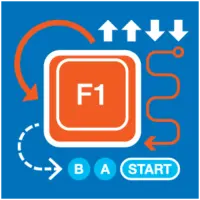Do More With Less

Design Problem:
Players cannot successfully undertake a sequence of actions required by the game.
Design Solution:
Players can reduce the number of actions in the sequence so that they can successfully make progress in the game.
Related Patterns:
APX Design Drivers:
The above design problem can occur in the following contexts:
Examples of this Pattern in Action
Keyboard play to reduce the number of key presses in Fantasy Strike
Description:
Fantasy Strike is a fighting game that allows players to use a keyboard-only set up for gameplay. On the left side of the keyboard, players only need to manage the left and right movement of respective player characters. A single button is dedicated to jumping on the right side of the keyboard along with a button for regular attacks, a button for throws, and two buttons for each of the two special attacks that a character has. The space bar is used for super attacks. To counter throws from the opposing character, players only need to refrain from pressing any buttons.
Fantasy Strike was developed so that there is no competitive advantage to using one type of controller vs a keyboard as the game is more about strategy than the fighting combos that can be strung together.
Automate actions in order to reduce button presses in Nier: Automata
Description:
Nier: Automata allows players to customize the player character through the game’s Plug-In Chip mechanic. Plug-In Chips allow players to tailor their character builds to their liking. Nier: Automata features a set of chips that automate certain elements of gameplay. On the game’s easy difficulty setting, players may equip auto-chips that allow the player character to automatically attack with melee, fire projectiles, evade enemy attacks, activate special attacks, and switch between weapons. These automatic actions can all be triggered by pressing the L2 button during gameplay. Since Nier: Automata allows the player to fully remap their controls, activation of auto-chips can be mapped to any button that the player wishes to use. In addition, there is also an NPC in one of the main hub areas of the game that explains the use of these auto-chips to the player.
On all difficulties, there are also auto-chips that for example, automatically trigger the use of items in specific scenarios. The effect of auto-chips on gameplay is that the player can reduce the amount of multitasking and management that would normally be required in a fast-paced action game like Nier: Automata.
Automate actions in order to reduce button presses in Final Fantasy 12: The Zodiac Age
Description:
In Final Fantasy 12: The Zodiac Age, players may use the gambit system to create a list of automated commands for each playable character that determines what actions they will take in various scenarios. The gambit system is comprised of “if-then” scenarios that players can choose and customize. Each gambit is comprised of a target (foe or ally), a condition (factors like proximity, current hit points, foes targeting specific allies, etc.), and an action that is taken on the target (chosen from a list of each character’s abilities and items). The following are examples of potential gambits:
- Example 1: If a foe [Target] is flying [Condition], then character X will attack [Action].
- Example 2: If an ally’s [Target] current hit points (HP) are less than 30% of their max hit points [Condition], then character X will use a potion on the ally [Action].
These gambits are listed in order of priority so that “Gambit #1” will occur before “Gambit #2” if the conditions for “Gambit #1” are met. If the conditions for a “Gambit #1” are not met, the character will automatically proceed to the next gambit in the sequence whose conditions are met.
With this system, players are essentially programming how their characters will behave in certain situations, thus, automating the gameplay. A player can choose to manage each action that a character takes, however that can become overwhelming with multiple characters to manage and/or multiple enemies to combat with. Manual inputs from players will always take priority over automated gambits, so players can still intervene as they wish. Players can also pause and adjust gambits to change the automated behavior of the playable characters.
References and Other Citations
Image for Final Fantasy 12: The Zodiac Age obtained from: Kotaku
